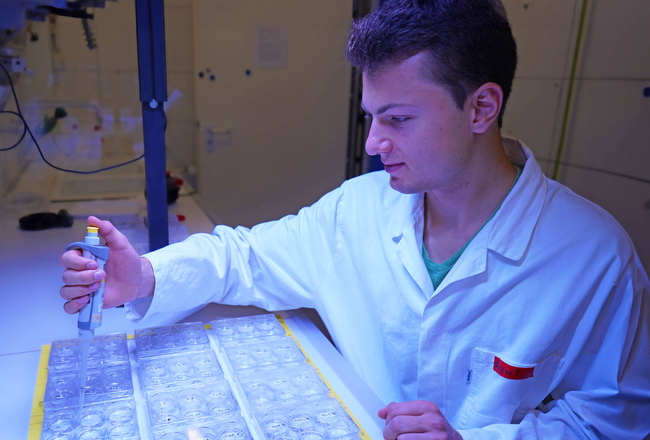The Symbio-Aid project, which is supported by the German Research Foundation, is investigating the reaction of foraminifera with their endosymbiotic algae to climate change and the associated bleaching events. The investigations should help to better understand bleaching and adaptation to changing temperatures. Here, Bachelor student Lukas Timme and Dr. Christiane Schmidt report on their project.
How did the idea for the project come about?
Christiane Schmidt: Due to climate change, extreme events are increasingly occurring, such as the rise in seawater temperature in coral reefs or the increase in typhoons affecting tropical coasts. In this project, we are investigating the ability of marine holobionts, i.e. organisms with all their symbionts, to adapt to climate change. The most sensitive part of certain holobionts such as corals and foraminifera is their symbiosis with microalgae like diatoms or dinoflagellates. Some of these symbionts are poorly adapted to the changed conditions. The basic question is therefore: can bleached holobionts take up and successfully store new microalgae?
What was the initial question of the project?
Lukas Timme: In my bachelor's thesis in the Symbio-Aid project, which is funded by the DFG, I am using the model organism Sorites orbiculus, a foraminifer, to investigate whether it takes up new endosymbiotic algal strains of the species Symbiodinium microadriaticum after artificial bleaching with menthol. In addition to the general flexibility of foraminifera in relation to their symbionts, I am also interested in the effect of the different endosymbiont strains on the physiology of these holobionts. I would also like to find out whether the foraminifera show a preferential uptake with respect to a particular endosymbiont strain.
How do you approach this question?
Lukas Timme: I am investigating the possibility of bleaching the foraminifera with menthol in the ZMT's seawater facility. I will then re-inoculate the bleached foraminifera with various endosymbiont strains. I can follow the uptake of the endosymbionts in a laser scanning microscope and record the physiological state of the foraminifera and algae using growth and PAM fluorometry measurements. In cooperation with MARUM, we will use modern molecular methods to see whether new symbionts have been taken up and quantify the uptake.
Why are these organisms of particular interest for the experiment?
Christiane Schmidt: Working with benthic foraminifera as model organisms for research into coral bleaching offers many advantages. They are easy to keep and experiments can be carried out with them in large numbers. They are also easier to obtain as, unlike corals, they are not protected by the Convention on International Trade in Endangered Species of Wild Fauna and Flora (CITES). This also allows experiments with natural populations, which means that the response of each organism is individual. Foraminifera also associate with more microalgae species than corals or other model organisms from coral reefs. They therefore offer a fascinating playground of possibilities for symbiosis research.
What new insights do you hope to gain?
Lukas Timme: We would like to gain a better understanding of the symbiosis between foraminifera and endosymbiotic algae. Based on the physiological response of the holobionts to the various inoculated endosymbiont strains, we hope to be able to draw conclusions about the adaptive potential of foraminifera in the face of rising sea temperatures.
What significance would the results of the experiment have?
Christiane Schmidt: A better understanding of the symbiosis between corals or foraminifera and microalgae will make it possible to assess the effects of ocean warming on coral reef ecosystems more precisely. This understanding of the basics also helps reef protection: if we find out that new symbionts are being stored, this is a great success, because it shows that the organisms can adapt, especially after bleaching events.
The targeted inoculation of corals or foraminifera with heat-tolerant endosymbionts could be used both to strengthen endangered coral reefs and to restore damaged coral reefs.
How could this research be continued?
Christiane Schmidt: Building on this experiment, we plan to conduct heat stress experiments with inoculated foraminifera in the Symbio-Aid project to better understand the influence of more heat-tolerant endosymbiont strains on the holobiont. If we prove that the holobiont becomes more heat tolerant, long-term research could be conducted to restore and strengthen damaged reefs.
More about the Symbio-Aid project: https://www.leibniz-zmt.de/en/research/research-projects/symbio-aid.html





